
DELICACY RESTAURANT
A menu management app for a restaurant based in New Delhi, India

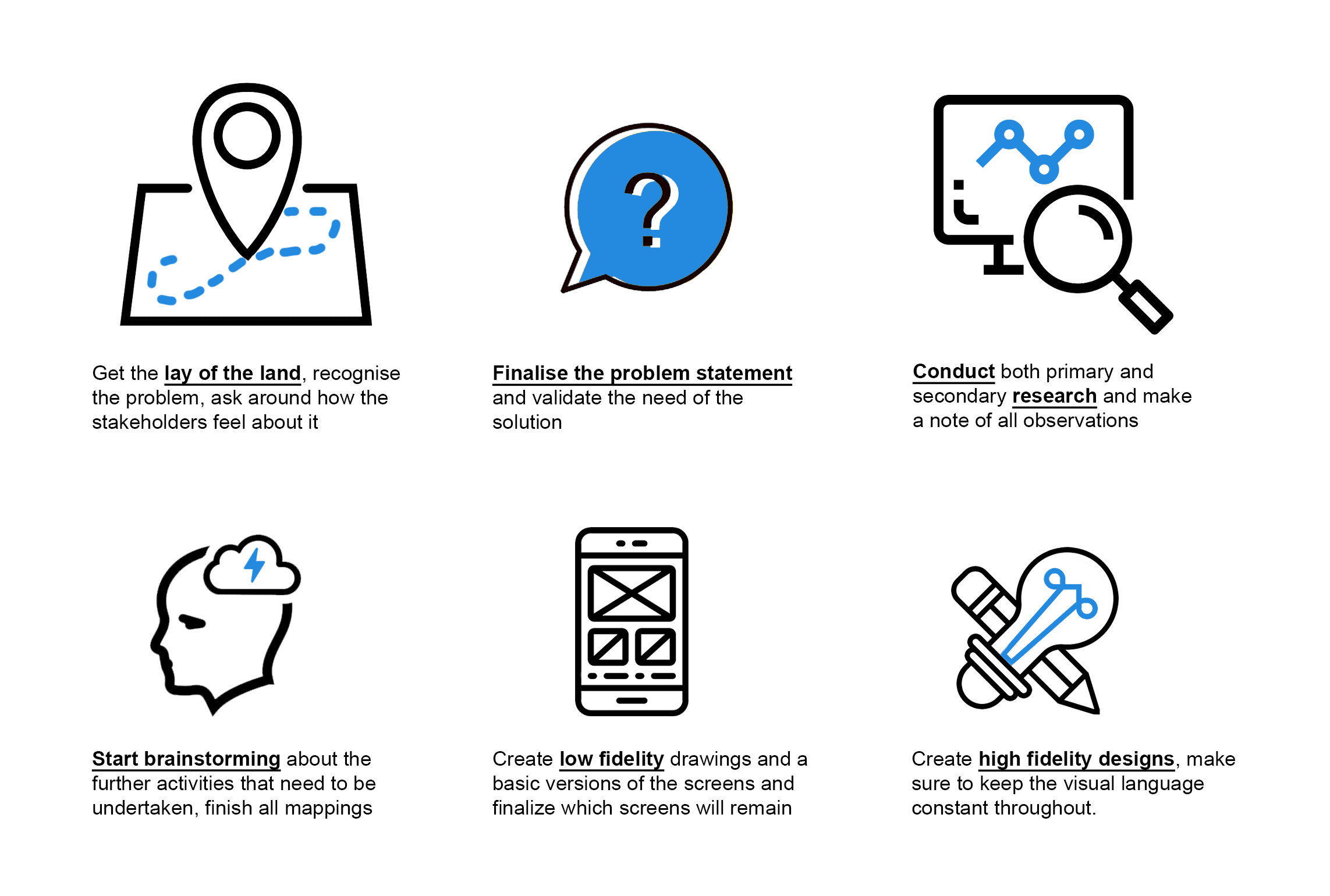
Design Process
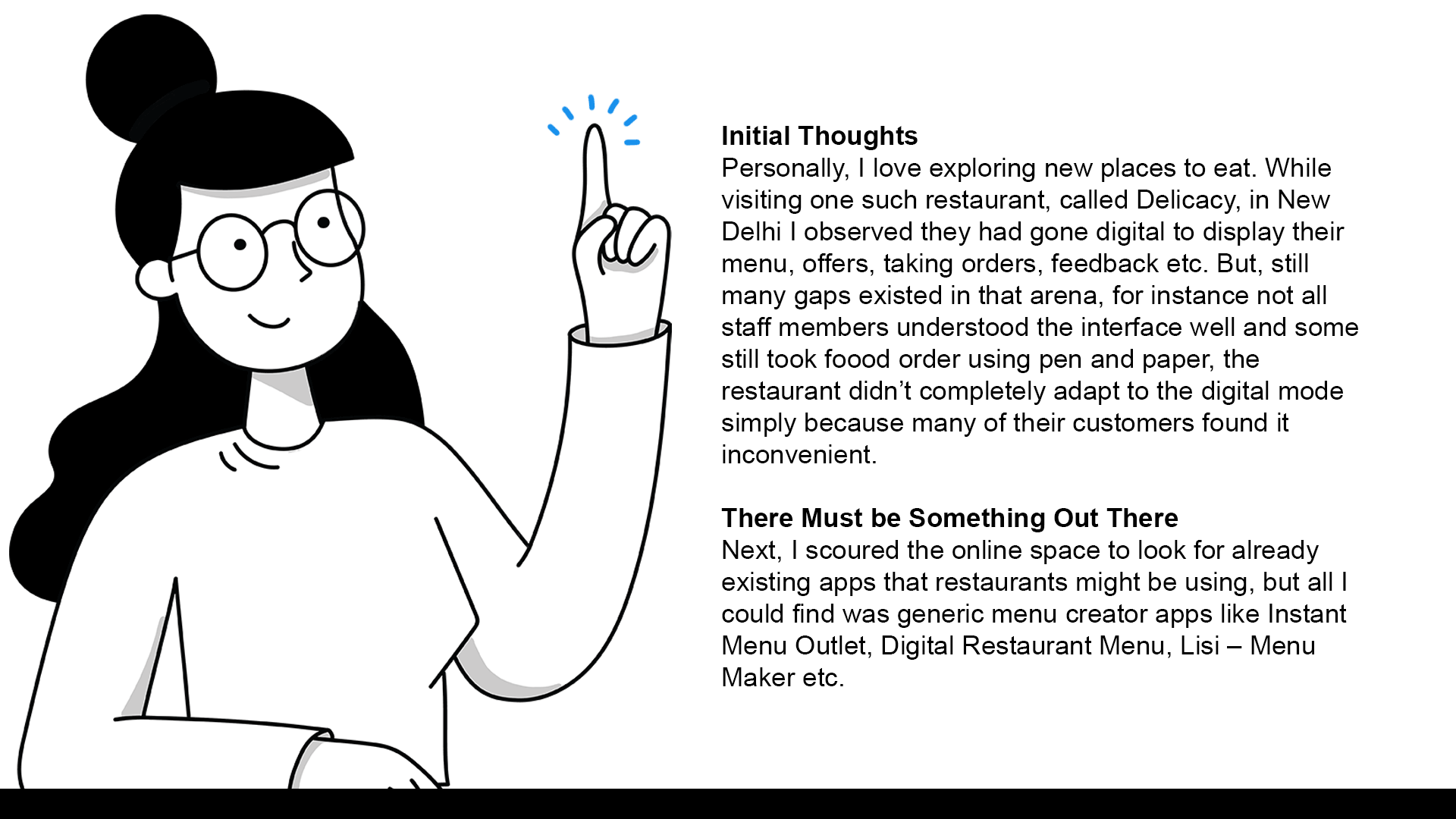

Preliminary Analysis (Sampled from 25 People)
Questions Asked to Customers

Questions Asked to Restaurant Staff

Competition Analysis

Radisson Blu Hotel, Restaurant App
The app allows the customers to view the menu, various categories of food and its prices. But the app doesn’t allow the user to order. But the staff takes order on paper only.
McDonald’s Restaurant App
The App enables the user to view the menu, multiple categories of food, customize their order and put in their table number as well. The app doesn’t allow the user to reserve a table. The staff in McDonald’s has appointed certain people to teach the users how to self-order.
Andhra Bhawan
The customers scan the QR code, that are put on their tables which takes them to an app page. On this page they can choose what to order, they cannot customize the ordered dishes. If they want some changes they have to go the billing counter and tell them.
Delicacy Restaurant
Their app is not for the customers but for the staff only. The staff is able to choose dishes, customize them in a limited manner. Through this application the chef in the kitchen gets update automatically. According to staff feedback even though all of them were regular smartphone users it took them quite a lot of time to get used to this application.
Barbeque Nation – Casual Dinin
The allows you to reserve a table, and buy a gift card for their friends as well. The app is essentially for delivery and take away and doesn’t allow customers to order from it when they are inside the restaurant.
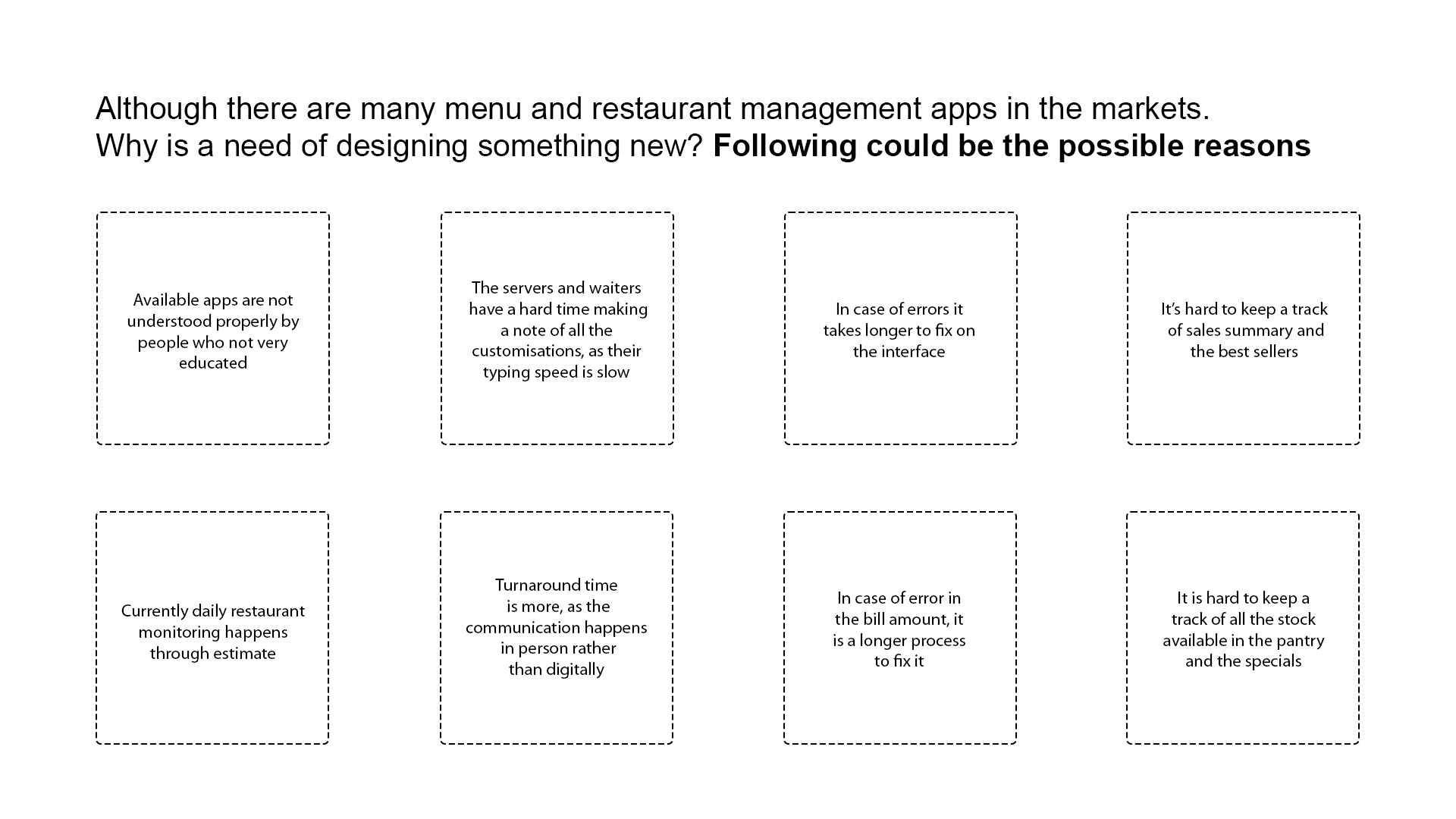
Assumption Mapping
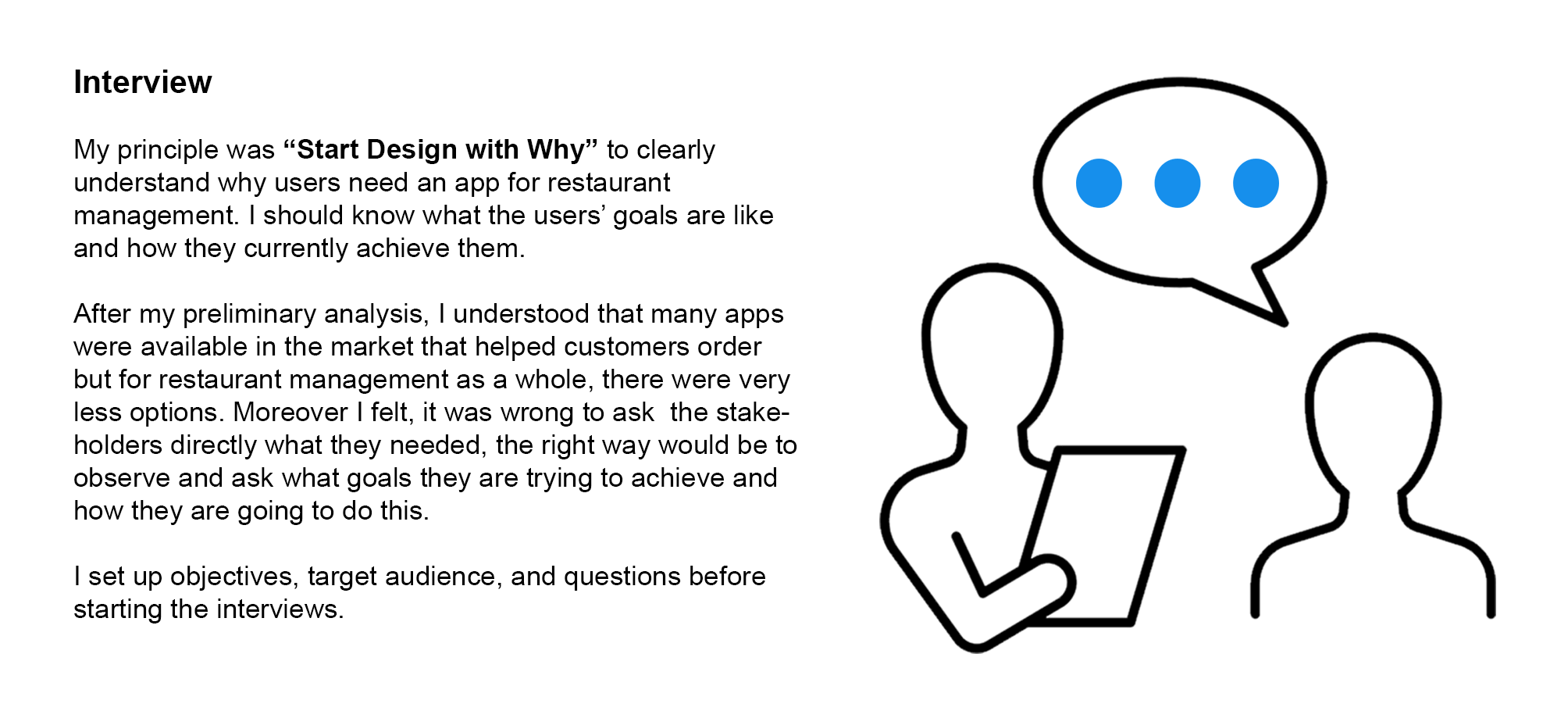
Interviews
Objectives:
Define what problems the servers and waiters go through when dealing with the customers and the kitchen staff? How they contribute towards managing the restaurant and what are their responsibilities?
Define how they currently solve problems. What tools and approaches they use?
Target audience:
I selected to interview different types of users—both male and female restaurant staff, with different level of experience in waiting on tables, people with different familiarity with technologies. People who serve customers often and occasionally.
Responses
From the interviews I inferred that most customers want
to know what are the ingredients in their food as many are worried about allergies and religious believes. Once the customers enter and settles down in the restaurant they don’t want to get up and order.
They prefer on the spot service instead of self service. The customers feel more satisfied if the staff wrote down/made a note of all the changes and customizations they have said. As they are reassured that their desires are heard.
The restaurant staff mostly memorize or write down orders and the number of tables they’ve served in a day. Initially it was difficult for them but over time they have inculcated the habit.
When asked whether they would want to experience a digital platform to take/manage orders, most of them were intrigued by the thought and were unsure as they were not confident about their technological aptitude.
But most of them also said that if a resource is made available to them they would love to give it a try.
Consumers wanted the following elements:
- Menu items
- Variants & add-ons
- Stock check (Mark available/unavailable)
- Take actions on items
- Daily Dish Report (number of items sold on daily basis along with the bestseller)
- First Time user experience (onboarding of new users)
- Reserve Tables

Corroborate
I used an affinity mapping method to find patterns in my observations and group them.
It helped me to get interesting information about my target users.

About The Users
Not so tech friendly, are usually adopters
in the age-group of 25-35.
FINALISING USER
Secondary Research
Analysing Problem Statement
In India, the restaurant business sees high growth and many investments, with new chains opening rapidly. For some of the older players, the time has come to consolidate their businesses or expand. This requires systematic management and oversight to ensure a smooth transition so that the fundamentals on which their businesses have been built are not sacrificed at the altar of growth.
Link: https://bootcamp.uxdesign.cc/case-study-designing-an-analytics-dashboard-for-a-dine-in-restaurant-manager-e67a4e728b5e
Key findings from Secondary Research:
- Studies from The Perry Group and The Restaurant Brokers suggest that 90% of independently owned restaurants close within one year of opening. Moreover, 70% of restaurants that survive for 12 months close their doors within three to five years.
- Businesses that use analytics can boost their profits by 8% to 10%. Still, only 12% of companies leverage the power of data.
- Studies have also shown that businesses that use analytics increased their productivity by 17% and improved their products or services by 12%.
- With advances in technology, you now have access to a wealth of valuable information about your customers, servers, payments, and more through your point of sale
Pain Points of Restaurant Managers:
In India, the restaurant business sees high growth and many investments, with new chains opening rapidly. For some of In the case of restaurants where they don’t use any analytics software, a lot of redundant manual labour is done. It’s hard to manage the data and extract insights from them quickly. Also, manual methods are not time efficient.
How might we digitalize the manual tasks done by restaurant managers and the waiters?”
Behaviour Analysis
Juggling customer orders, staff hours and tasks, menus, and inventories is one of the minor technological miracles in the age-old foodservice industry. Without a restaurant management app that can handle these sundry elements, there is no chance today’s food establishments can survive the way they do.
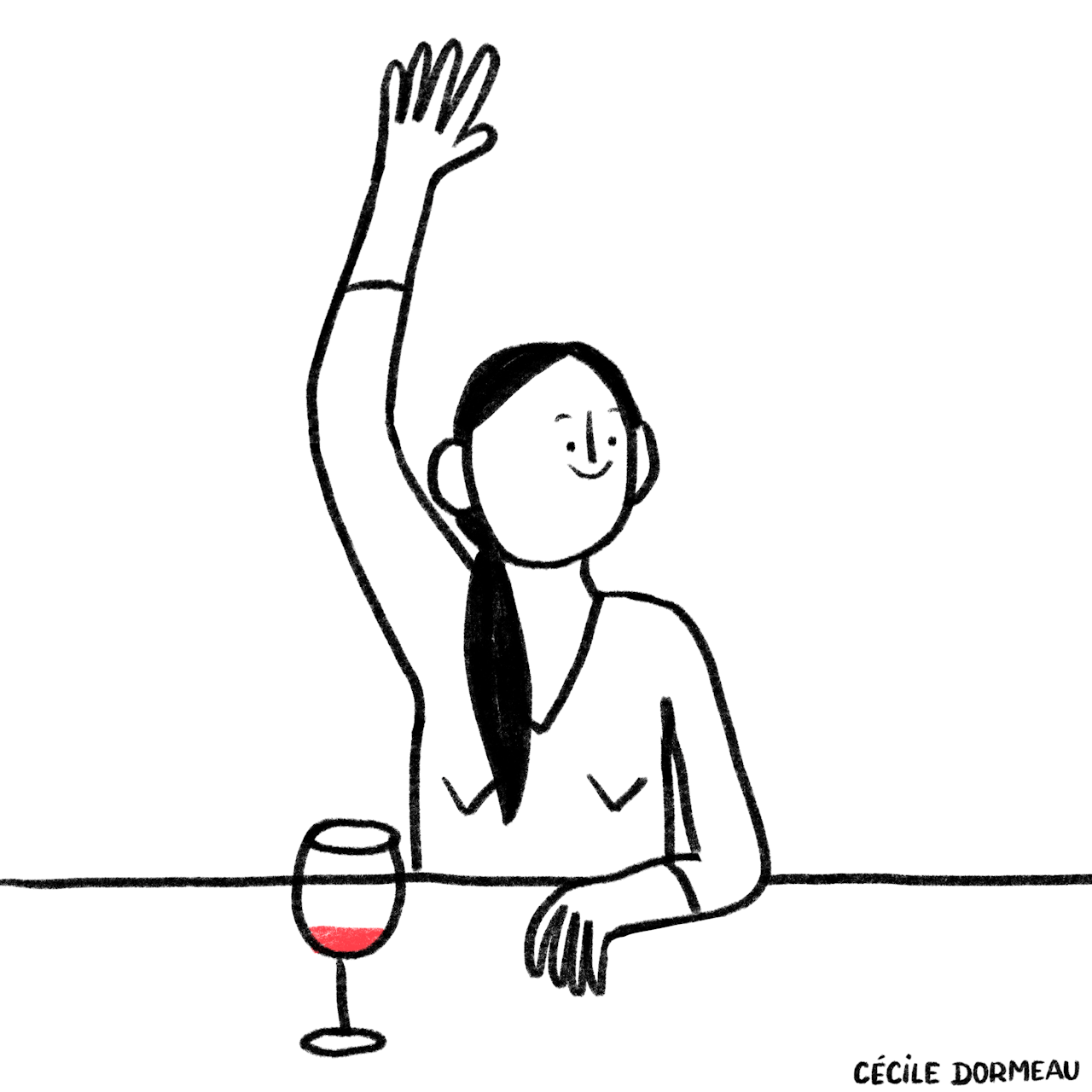
Customers
Although, in contrast, each customer’s preferences are different, a few markers that standout restaurant experiences share in common:
- Friendly, personalised service
- Consistently great food
- Great Ambiance
- Efficient Customer Service
Waiters
- Quicken the order taking process
- Ensure dine-in and takeaway orders are delivered accurately
- Monitor your restaurant’s performance.
- Convey modifiers or special requests
- Perform the required action for each table.
- Modify orders and menu items by adding and subtracting
- Can cover order level discounts


Managers
Restaurant managers are responsible for overseeing the efficient running and profitability of restaurants and for managing their employees. Typical job responsibilities of a manager include:
- Recruiting, training and supervising staff
- Agreeing and managing budgets
- Planning menus
- Promoting and marketing the business
- Handling customer enquiries and complaints
- Preparing and presenting staffing/sales reports
- Keeping statistical and financial records
- Assessing and improving profitability
Types of People Who Would Want To Use a Menu And Restaurant Management App:

User Persona
From the data I collected, I created an ideal user flow as how I imagined my app to pan out and what my desired user experience would entail. It later developed into an experience map, which captured the user’s journey and emotional results with each touchpoint they perform within the app.


Empathy Map

Journey Mapping



Ideation and Brainstorming
Based on all the research and user interviews, the following goals were taken as primary goals for the product. Following goals will also act as pillars of the platform.
Since not a lot of time will be dedicated towards the training of the employees and the servers need to be quick while taking orders from the customers the proposed platform needs to be self-explanatory and should have a conventional interface with some customizations.
The server should be able to easily add items, delete them and customize them according to the consumer needs.
Many a times the consumers ask the servers for recommendations, thus the servers will have an option on the proposed platform to see the best- selling dish, how many of it has been sold in the last hour, week etc. The platform will also have information about the dishes ingredients and calories. So that the customer can make an informed choice.
Since the servers come in direct contact with the customers and interact the most with them, the platform will have a feature where the servers will be able to upload their observations about the liking and disliking’s of the customers and also make recommendations.
In addition to the main menu, stock check and add on options , the platform will also provide the servers an options to filter out dishes on the basis of cuisines, so that it becomes easier for them to find a certain option while taking a customer’s order.
Many times customers suffer from allergies and other medical issues due to which they can’t eat certain ingredients, in the customization tab for consumers who are suffering from allergies, a warning trigger will be generated by the server on the platform while taking the order, so that the chef in the kitchen becomes extra careful while cooking the ordered food.
The recipes of all the dishes should also be available on the proposed platform, so that if a customer asks, the servers will have easy access to all the information.
Story-Boarding:


Concept Map

Emphasis On:
De - Emphasis On:



System Conceptualisation

Server's Journey
Manager's Journey

Low Fidelity



Visual Style

High Fidelity Designs



